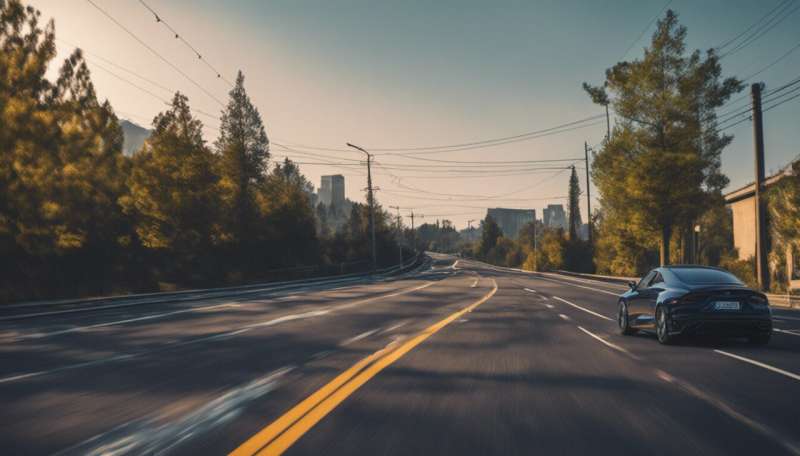This article has been reviewed according to Science X's editorial process and policies. Editors have highlighted the following attributes while ensuring the content's credibility:
fact-checked
trusted source
written by researcher(s)
proofread
Batteries in electric vehicles have more mileage in city driving rather than highway driving

A Toyota Corolla with a 1.8L engine requires 6.2 liters of gas to drive for 100 kilometers on a highway. But on city roads, it would require 7.9 liters of gas. A 2022 Ford F-150 requires 9.4 and 12.1 liters per 100 km for highway and city driving, respectively.
Traditional fuel-powered automobiles, powered by the internal combustion engines, give higher mileage on a highway compared to city roads. Various factors can affect the driving efficiency of a vehicle.
First, the internal combustion engines are designed in a way that their efficiency peaks closer to highway speeds. Second, unlike highway driving, city driving involves more frequent acceleration and braking; every time a fuel-powered automobile accelerates, it consumes more energy than it would consume to maintain speed. And every time it brakes, energy is lost in the form of heat at its brake pads.
All these factors result in higher gas mileage on highway driving compared to city driving.
Power usage
Battery electric vehicles (BEVs) don't need gasoline. So how much electric power is needed to drive a BEV on highways? And will that power requirement be higher (or lower) to drive in the city?
It could be expected that a BEV would require less power to drive on a highway compared to city. And a fully charged BEV should be able to drive longer on a highway compared to the city. However, the reality is just the opposite.
Energy stored in the battery is measured in kilowatt-hours (KWh). If a particular BEV has a capacity of 200 KWh, this would ideally provide 200 KW (equivalent to 268 horsepower) for one hour, or 100 KWh for two hours, and so on. Hypothetically, this BEV can provide an impressive 2,680 hp for six minutes, and an astounding 26,800 hp for 36 seconds.
In practice, however, the internal resistance of the battery prevents it from providing infinite power even for a short time. When trying to draw high power from the battery, its internal resistance causes a voltage drop that is high enough to completely shut it off.
When the BEV operates at high power, only a certain portion of the full energy capacity is available for driving. At a lower power, however, the battery can provide more energy.
Battery testing
We conducted experiments at our battery management systems research lab at the University of Windsor. We took a cylindrical battery cell like the ones used to make battery packs for BEVs and computed its energy at different discharge currents.
First, we fully charged the battery and then discharged it at a certain power until it was fully depleted. Then, we fully charged it again and discharged it at half the power until it was fully depleted. The experiment was repeated five more times by halving the discharge power each time.
When we computed the total energy discharged by the battery at each experiment, we found that the lower the current, the higher the discharge energy capacity.
The BEVs need more electrical current (a measure of power) on highways compared to city streets because the average speed on the highway is higher. Also, their batteries become less efficient at high currents due to energy loss.
Further, the BEVs don't lose that much power when braking because they convert their kinetic energy back to electricity with the help of regenerative braking systems. All these facts contribute to more efficient driving and higher range at low speeds.
The batteries perform well at room temperature, and colder and hotter temperatures will reduce their performance. Similarly, using vehicle heating, ventilation and air conditioning systems will reduce the batteries' performance.
The performance of a battery is also affected by how it is being used over time. The battery management system is very important, and in some BEVs, it may be programmed to prevent the driver from fully depleting the battery pack so that long-term health can be maintained.
Informed consumers
Canada's 2022 fuel consumption guide provides details about some BEVs. On average, the tested BEVs required lower power to drive 100 kilometers in city roads compared to highways, confirming our explanation.
A study by the American Automobile Association found that most vehicles drove the longest in city conditions where speed was lower compared to highway driving. That is, a fully charged BEV drives longer distances at lower speeds.
Our findings suggest that those considering an electric vehicle would find it useful if power consumption guides included this information. BEV drivers can expect shorter driving range at high speeds, and can also expect the driving cost per kilometer to increase with vehicle speed.
This article is republished from The Conversation under a Creative Commons license. Read the original article.![]()


















